Ancient Civilizations: Comparative Analysis of Development and Decline
VerifiedAdded on 2022/09/08
|5
|1045
|17
Essay
AI Summary
This essay provides a comprehensive overview of ancient civilizations, tracing their development from the Paleolithic Era through the Bronze Age, the rise of Greek and Roman societies, and the emergence of Indian and Mesopotamian civilizations. It explores key aspects such as social structures, religious beliefs, political systems, and architectural achievements. The essay analyzes the factors contributing to the rise and fall of these civilizations, highlighting their unique characteristics and contributions to human history. It discusses the significance of trade, cultural exchange, and the impact of these ancient societies on modern urban development, political thought, and artistic expression. The essay draws upon various historical sources and scholarly works to provide a comparative analysis of these influential civilizations, emphasizing their legacies and their relevance to understanding the present world.
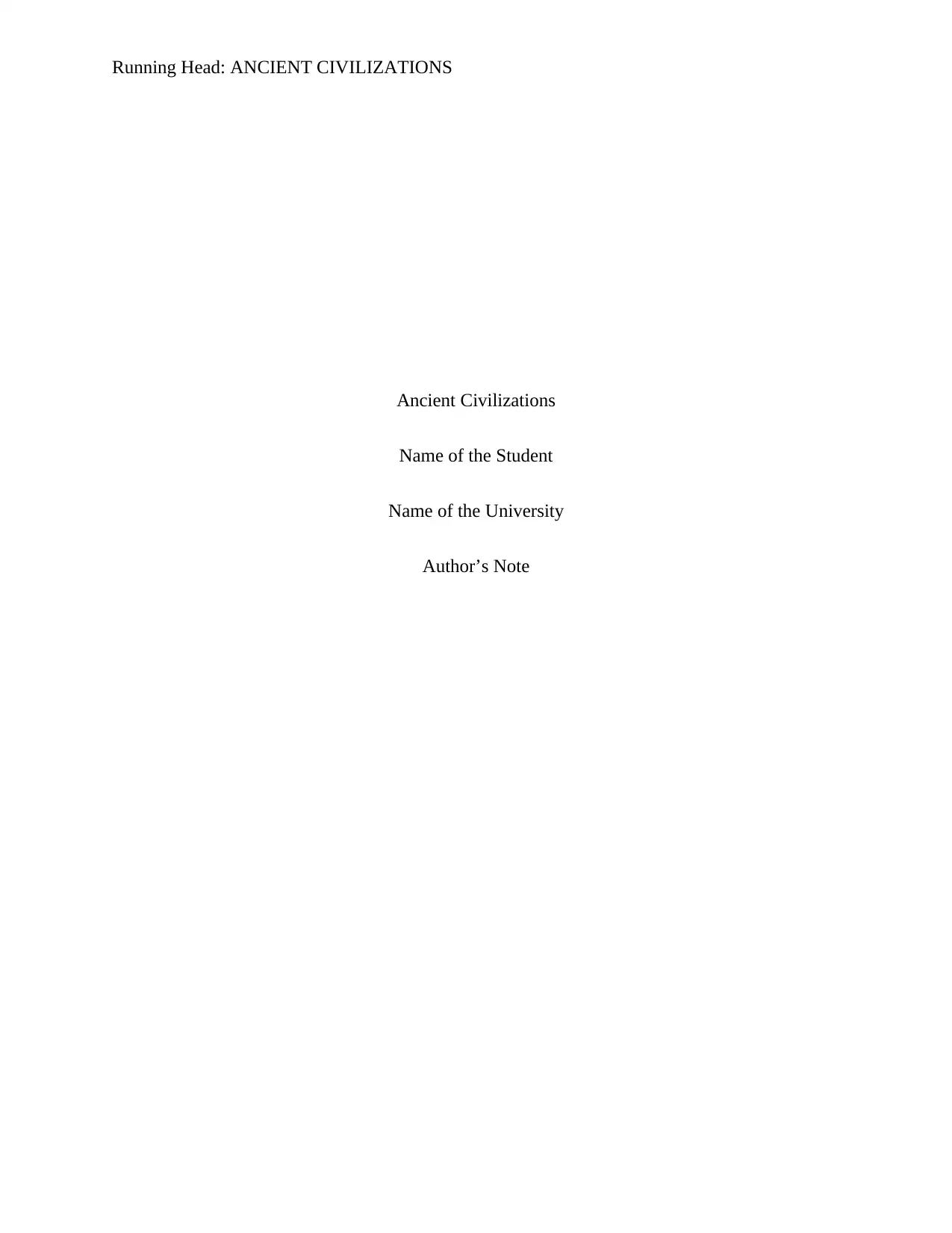
Running Head: ANCIENT CIVILIZATIONS
Ancient Civilizations
Name of the Student
Name of the University
Author’s Note
Ancient Civilizations
Name of the Student
Name of the University
Author’s Note
Paraphrase This Document
Need a fresh take? Get an instant paraphrase of this document with our AI Paraphraser
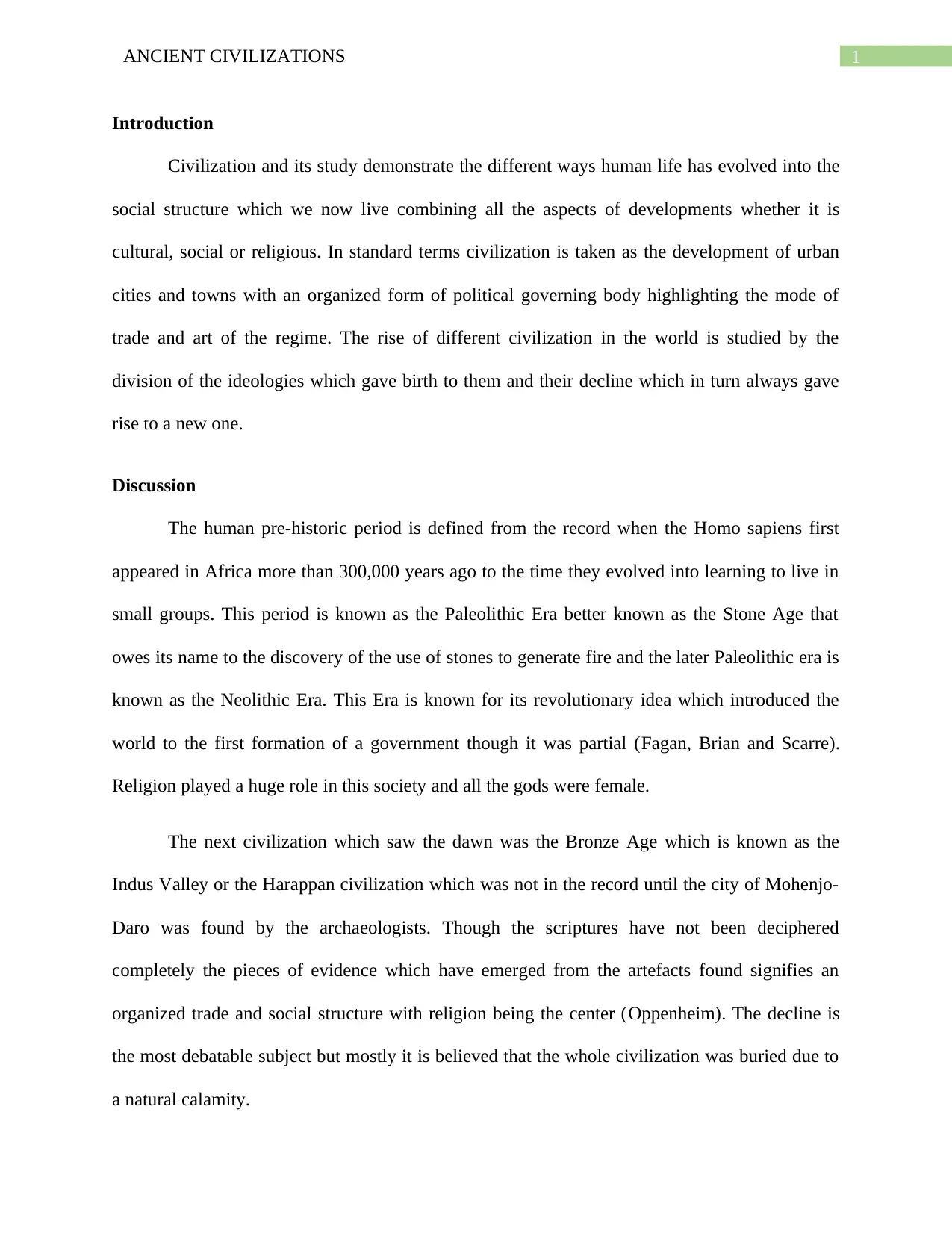
1ANCIENT CIVILIZATIONS
Introduction
Civilization and its study demonstrate the different ways human life has evolved into the
social structure which we now live combining all the aspects of developments whether it is
cultural, social or religious. In standard terms civilization is taken as the development of urban
cities and towns with an organized form of political governing body highlighting the mode of
trade and art of the regime. The rise of different civilization in the world is studied by the
division of the ideologies which gave birth to them and their decline which in turn always gave
rise to a new one.
Discussion
The human pre-historic period is defined from the record when the Homo sapiens first
appeared in Africa more than 300,000 years ago to the time they evolved into learning to live in
small groups. This period is known as the Paleolithic Era better known as the Stone Age that
owes its name to the discovery of the use of stones to generate fire and the later Paleolithic era is
known as the Neolithic Era. This Era is known for its revolutionary idea which introduced the
world to the first formation of a government though it was partial (Fagan, Brian and Scarre).
Religion played a huge role in this society and all the gods were female.
The next civilization which saw the dawn was the Bronze Age which is known as the
Indus Valley or the Harappan civilization which was not in the record until the city of Mohenjo-
Daro was found by the archaeologists. Though the scriptures have not been deciphered
completely the pieces of evidence which have emerged from the artefacts found signifies an
organized trade and social structure with religion being the center (Oppenheim). The decline is
the most debatable subject but mostly it is believed that the whole civilization was buried due to
a natural calamity.
Introduction
Civilization and its study demonstrate the different ways human life has evolved into the
social structure which we now live combining all the aspects of developments whether it is
cultural, social or religious. In standard terms civilization is taken as the development of urban
cities and towns with an organized form of political governing body highlighting the mode of
trade and art of the regime. The rise of different civilization in the world is studied by the
division of the ideologies which gave birth to them and their decline which in turn always gave
rise to a new one.
Discussion
The human pre-historic period is defined from the record when the Homo sapiens first
appeared in Africa more than 300,000 years ago to the time they evolved into learning to live in
small groups. This period is known as the Paleolithic Era better known as the Stone Age that
owes its name to the discovery of the use of stones to generate fire and the later Paleolithic era is
known as the Neolithic Era. This Era is known for its revolutionary idea which introduced the
world to the first formation of a government though it was partial (Fagan, Brian and Scarre).
Religion played a huge role in this society and all the gods were female.
The next civilization which saw the dawn was the Bronze Age which is known as the
Indus Valley or the Harappan civilization which was not in the record until the city of Mohenjo-
Daro was found by the archaeologists. Though the scriptures have not been deciphered
completely the pieces of evidence which have emerged from the artefacts found signifies an
organized trade and social structure with religion being the center (Oppenheim). The decline is
the most debatable subject but mostly it is believed that the whole civilization was buried due to
a natural calamity.
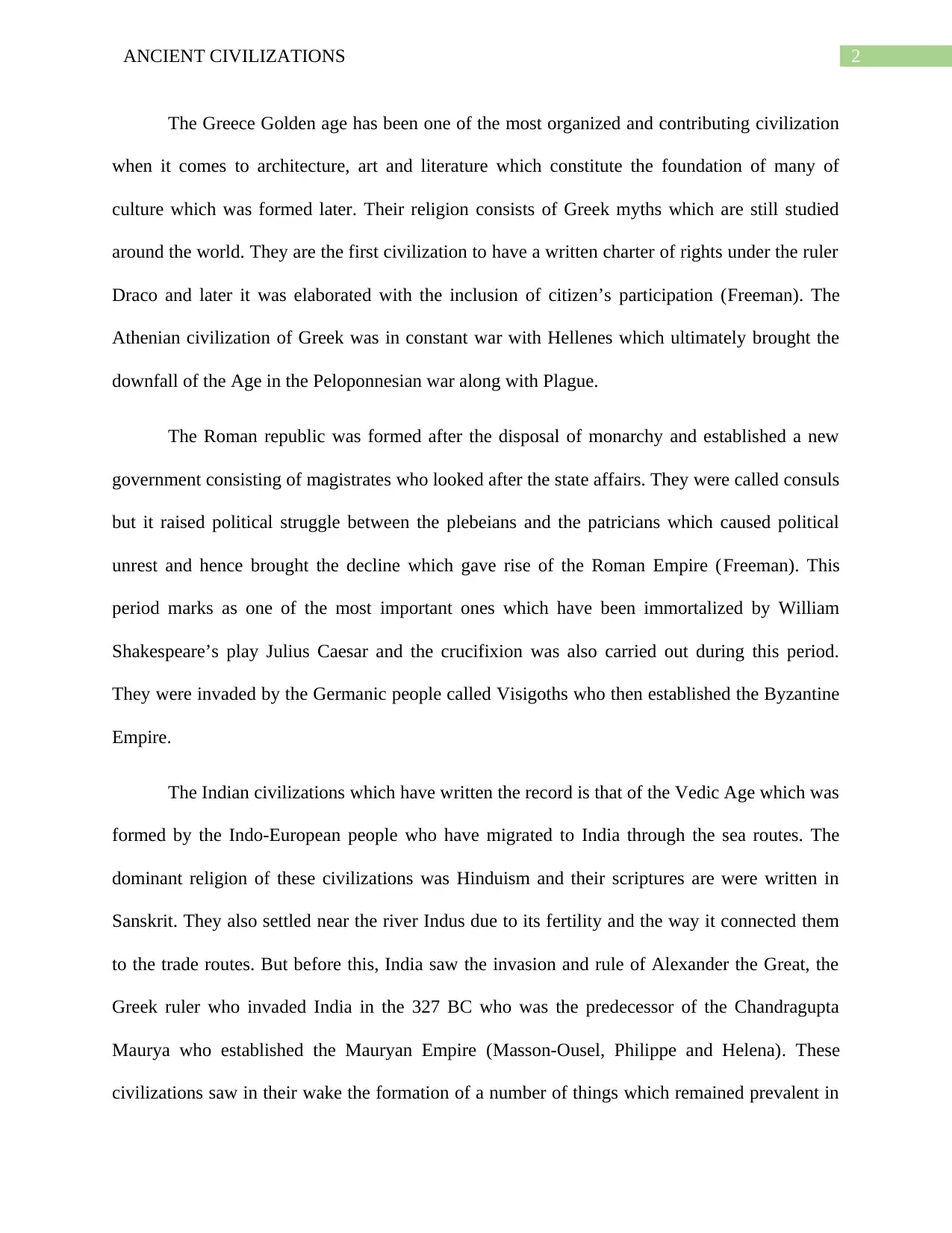
2ANCIENT CIVILIZATIONS
The Greece Golden age has been one of the most organized and contributing civilization
when it comes to architecture, art and literature which constitute the foundation of many of
culture which was formed later. Their religion consists of Greek myths which are still studied
around the world. They are the first civilization to have a written charter of rights under the ruler
Draco and later it was elaborated with the inclusion of citizen’s participation (Freeman). The
Athenian civilization of Greek was in constant war with Hellenes which ultimately brought the
downfall of the Age in the Peloponnesian war along with Plague.
The Roman republic was formed after the disposal of monarchy and established a new
government consisting of magistrates who looked after the state affairs. They were called consuls
but it raised political struggle between the plebeians and the patricians which caused political
unrest and hence brought the decline which gave rise of the Roman Empire (Freeman). This
period marks as one of the most important ones which have been immortalized by William
Shakespeare’s play Julius Caesar and the crucifixion was also carried out during this period.
They were invaded by the Germanic people called Visigoths who then established the Byzantine
Empire.
The Indian civilizations which have written the record is that of the Vedic Age which was
formed by the Indo-European people who have migrated to India through the sea routes. The
dominant religion of these civilizations was Hinduism and their scriptures are were written in
Sanskrit. They also settled near the river Indus due to its fertility and the way it connected them
to the trade routes. But before this, India saw the invasion and rule of Alexander the Great, the
Greek ruler who invaded India in the 327 BC who was the predecessor of the Chandragupta
Maurya who established the Mauryan Empire (Masson-Ousel, Philippe and Helena). These
civilizations saw in their wake the formation of a number of things which remained prevalent in
The Greece Golden age has been one of the most organized and contributing civilization
when it comes to architecture, art and literature which constitute the foundation of many of
culture which was formed later. Their religion consists of Greek myths which are still studied
around the world. They are the first civilization to have a written charter of rights under the ruler
Draco and later it was elaborated with the inclusion of citizen’s participation (Freeman). The
Athenian civilization of Greek was in constant war with Hellenes which ultimately brought the
downfall of the Age in the Peloponnesian war along with Plague.
The Roman republic was formed after the disposal of monarchy and established a new
government consisting of magistrates who looked after the state affairs. They were called consuls
but it raised political struggle between the plebeians and the patricians which caused political
unrest and hence brought the decline which gave rise of the Roman Empire (Freeman). This
period marks as one of the most important ones which have been immortalized by William
Shakespeare’s play Julius Caesar and the crucifixion was also carried out during this period.
They were invaded by the Germanic people called Visigoths who then established the Byzantine
Empire.
The Indian civilizations which have written the record is that of the Vedic Age which was
formed by the Indo-European people who have migrated to India through the sea routes. The
dominant religion of these civilizations was Hinduism and their scriptures are were written in
Sanskrit. They also settled near the river Indus due to its fertility and the way it connected them
to the trade routes. But before this, India saw the invasion and rule of Alexander the Great, the
Greek ruler who invaded India in the 327 BC who was the predecessor of the Chandragupta
Maurya who established the Mauryan Empire (Masson-Ousel, Philippe and Helena). These
civilizations saw in their wake the formation of a number of things which remained prevalent in
⊘ This is a preview!⊘
Do you want full access?
Subscribe today to unlock all pages.

Trusted by 1+ million students worldwide
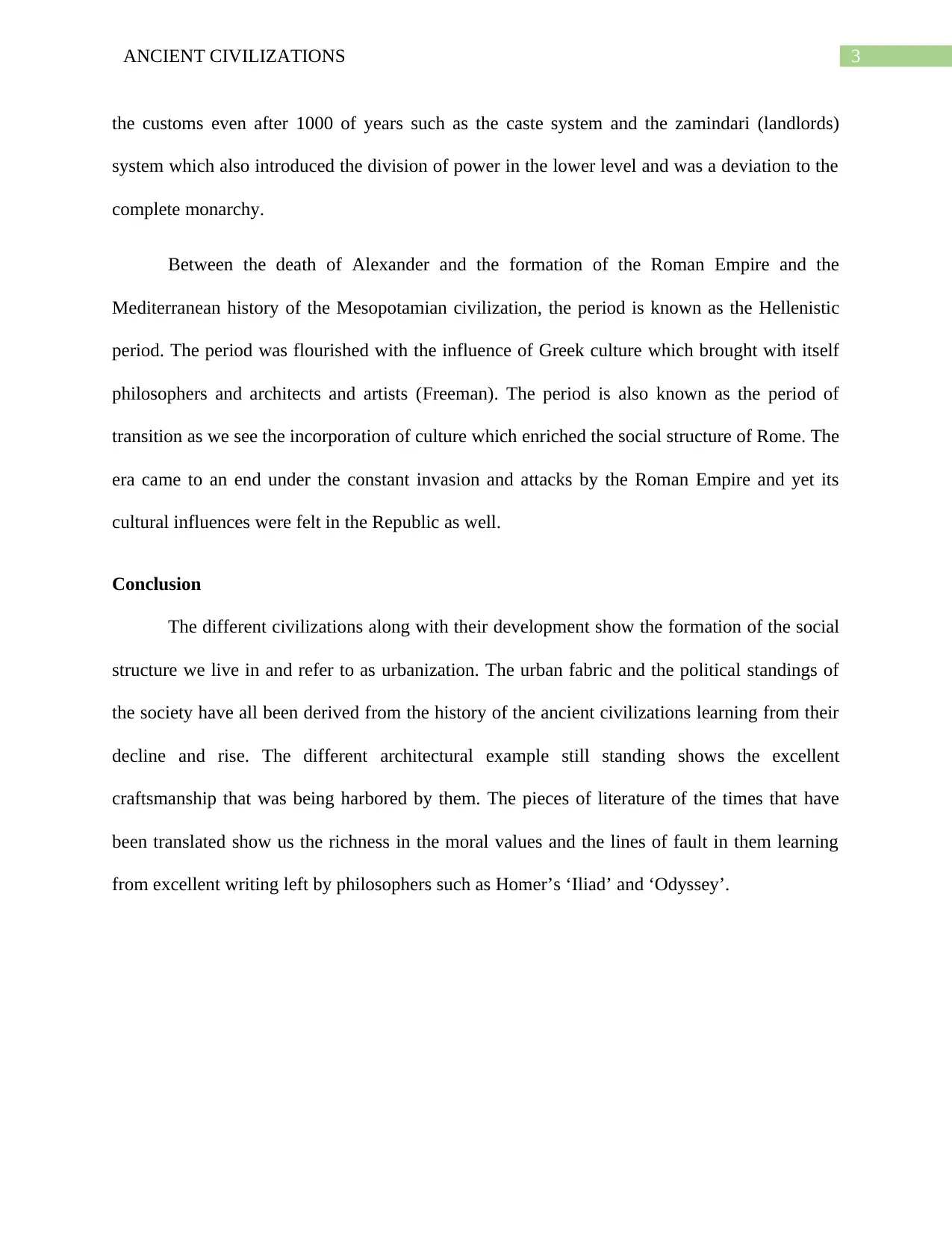
3ANCIENT CIVILIZATIONS
the customs even after 1000 of years such as the caste system and the zamindari (landlords)
system which also introduced the division of power in the lower level and was a deviation to the
complete monarchy.
Between the death of Alexander and the formation of the Roman Empire and the
Mediterranean history of the Mesopotamian civilization, the period is known as the Hellenistic
period. The period was flourished with the influence of Greek culture which brought with itself
philosophers and architects and artists (Freeman). The period is also known as the period of
transition as we see the incorporation of culture which enriched the social structure of Rome. The
era came to an end under the constant invasion and attacks by the Roman Empire and yet its
cultural influences were felt in the Republic as well.
Conclusion
The different civilizations along with their development show the formation of the social
structure we live in and refer to as urbanization. The urban fabric and the political standings of
the society have all been derived from the history of the ancient civilizations learning from their
decline and rise. The different architectural example still standing shows the excellent
craftsmanship that was being harbored by them. The pieces of literature of the times that have
been translated show us the richness in the moral values and the lines of fault in them learning
from excellent writing left by philosophers such as Homer’s ‘Iliad’ and ‘Odyssey’.
the customs even after 1000 of years such as the caste system and the zamindari (landlords)
system which also introduced the division of power in the lower level and was a deviation to the
complete monarchy.
Between the death of Alexander and the formation of the Roman Empire and the
Mediterranean history of the Mesopotamian civilization, the period is known as the Hellenistic
period. The period was flourished with the influence of Greek culture which brought with itself
philosophers and architects and artists (Freeman). The period is also known as the period of
transition as we see the incorporation of culture which enriched the social structure of Rome. The
era came to an end under the constant invasion and attacks by the Roman Empire and yet its
cultural influences were felt in the Republic as well.
Conclusion
The different civilizations along with their development show the formation of the social
structure we live in and refer to as urbanization. The urban fabric and the political standings of
the society have all been derived from the history of the ancient civilizations learning from their
decline and rise. The different architectural example still standing shows the excellent
craftsmanship that was being harbored by them. The pieces of literature of the times that have
been translated show us the richness in the moral values and the lines of fault in them learning
from excellent writing left by philosophers such as Homer’s ‘Iliad’ and ‘Odyssey’.
Paraphrase This Document
Need a fresh take? Get an instant paraphrase of this document with our AI Paraphraser
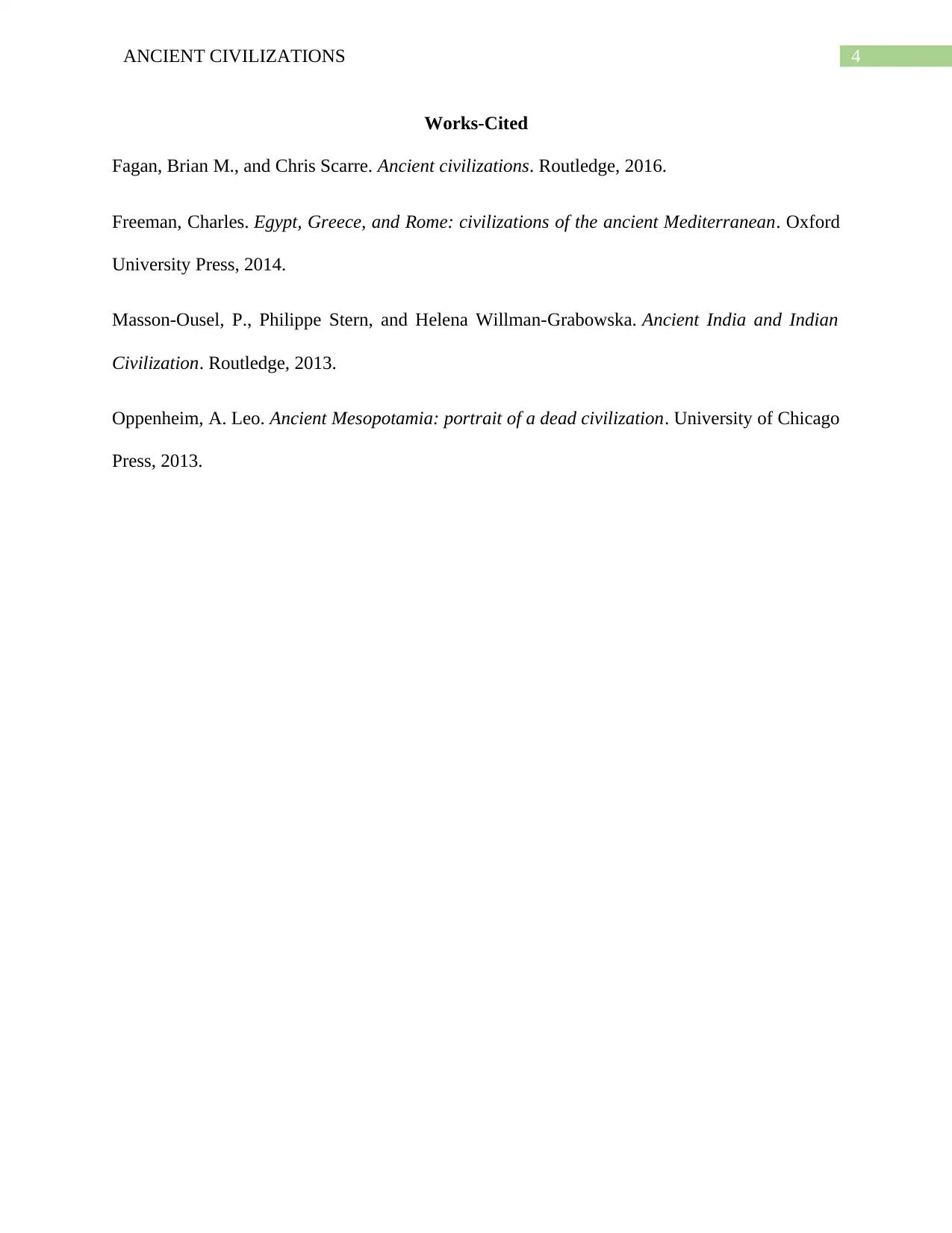
4ANCIENT CIVILIZATIONS
Works-Cited
Fagan, Brian M., and Chris Scarre. Ancient civilizations. Routledge, 2016.
Freeman, Charles. Egypt, Greece, and Rome: civilizations of the ancient Mediterranean. Oxford
University Press, 2014.
Masson-Ousel, P., Philippe Stern, and Helena Willman-Grabowska. Ancient India and Indian
Civilization. Routledge, 2013.
Oppenheim, A. Leo. Ancient Mesopotamia: portrait of a dead civilization. University of Chicago
Press, 2013.
Works-Cited
Fagan, Brian M., and Chris Scarre. Ancient civilizations. Routledge, 2016.
Freeman, Charles. Egypt, Greece, and Rome: civilizations of the ancient Mediterranean. Oxford
University Press, 2014.
Masson-Ousel, P., Philippe Stern, and Helena Willman-Grabowska. Ancient India and Indian
Civilization. Routledge, 2013.
Oppenheim, A. Leo. Ancient Mesopotamia: portrait of a dead civilization. University of Chicago
Press, 2013.
1 out of 5
Related Documents
Your All-in-One AI-Powered Toolkit for Academic Success.
+13062052269
info@desklib.com
Available 24*7 on WhatsApp / Email
![[object Object]](/_next/static/media/star-bottom.7253800d.svg)
Unlock your academic potential
Copyright © 2020–2025 A2Z Services. All Rights Reserved. Developed and managed by ZUCOL.
![Art History: Comparing Greek and Roman Art, [University Name]](/_next/image/?url=https%3A%2F%2Fdesklib.com%2Fmedia%2Fimages%2Fxg%2F6bc872f5e2ed4cb793eeeb5c835ed261.jpg&w=256&q=75)



